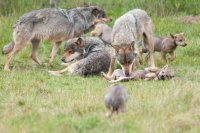Photo: Hugh Jansman
They are calling me Wolf A28, after the place where I died at the beginning of March. I was crossing the road between Meppel and Hoogeveen at night when a pair of headlamps suddenly bore down upon me at amazing speed. And now here I am on a dissecting table in Utrecht, where plastic-gloved hands inspect me and my stomach is cut out of my body with sharp knives.
I was born one and a half years ago in the German region of Lower Saxony, close to the little down of Cuxhaven. I grew up with my family in Langes Moor nature reserve. My parents come from eastern Germany and moved into this area north of Bremen in 2012. I was born in 2015, along with a handful of siblings. Another five cubs were born into our Cuxhaven pack in 2016.
The local forest rangers collected our poo and used it to identify the DNA of my family. They brought that DNA to a research institute in Senckenberg, which has a database of genetic material from German wolf packs. That made it possible for the Wageningen researcher Arjen de Groot to use a DNA match after my death to establish that I came from the Cuxhaven pack.
Lone wolve
This spring, after I had helped raise my little brothers and sisters from the latest brood, I left the pack. That is not unusual for young male wolves of eight months and above. I made the decision together with my parents. Our habitat near Cuxhaven is not very big so young males like me often go roaming in search of a new territory and a mate. I came to the Netherlands as a ‘lone wolf’ in the hope of starting a family here.
The distance between Cuxhaven and Veeningen is about 200 kilometres, but I must have covered at least twice that. After all, a wolf has to eat, and I had to go hunting for roe deer, red deer and wild boar. They are mainly to be found in forest and the grasslands bordering them. I did most of my travelling by night. That way I could cover a lot of ground as I travelled across farmland. It was especially during the day that I had to watch out. Forty percent of the wolves in Germany die on the roads and another forty percent get shot illegally.
Little Red Riding Hood
I don’t have a problem with people, but people certainly have a problem with me. They call it the Little Red Riding Hood syndrome. They’ve got this idea that I gobble up innocent little girls, bedridden grandmas and baby goats. It’s not true. My diet consists mainly of roe deer, red deer and wild boar, as well as some smaller game. My last meal before I died on the A28 was a hare. Wolves do stray from the straight and narrow now and then though, admittedly. Last year my mother ate a couple of calves on farms near Langes Moor. Which cost her dear. She was categorized as ‘aggressive’ and shot – legally – by hunters.
If I hadn’t been run over, I might have gone back to Langes Moor. We wolves often do that, go back to our family after a spell away. We have a busier social life than human beings realize.

Military training areas
We western European wolves benefit a lot from the vast military training areas in Germany that became available to us after the lifting of the Iron Curtain. No human beings come onto those closed-off terrains, so we can settle there, mate and start families. There are a few military training areas in the Netherlands too, at Harskamp and ’t Harde, but reaching them is quite an undertaking. I didn’t make it.
Another wolf is sure to try it after me, and maybe he will make it. The only question is how long he will survive. This country is extremely full and we need a large territory. We need to be able to roam 30 kilometres from our lairs to find food. In the Netherlands that nearly always means crossing roads. And that reduces our chances of survival – as my story shows.
This story is based on the knowledge of wolves of Hugh Jansman of Wageningen Environmental Research.
Dead wolves
In Germany, records are kept of the cause of death in wolves. Between May 2014 and April 2015, 14 wolves died in the federal states of Saxony and Brandenburg. Seven died on the roads, five were shot illegally, one died a natural death and the cause of the last wolf’s death was not clear. Six of the wolves were adults, four were yearlings and four were cubs. Researcher Hugh Jansman suspects that more wolves get shot dead but do not appear in the statistics because they are buried in secret.
